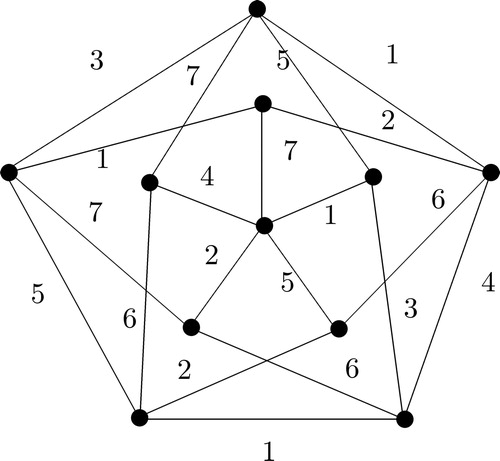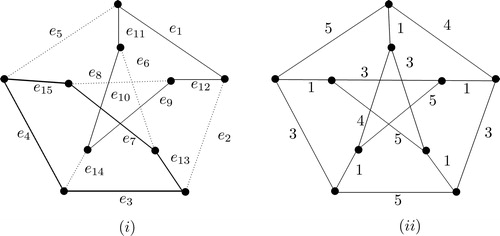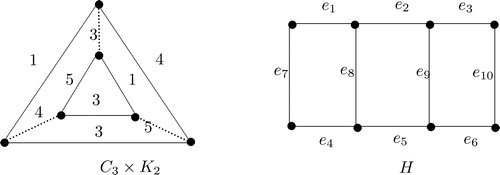 ?Mathematical formulae have been encoded as MathML and are displayed in this HTML version using MathJax in order to improve their display. Uncheck the box to turn MathJax off. This feature requires Javascript. Click on a formula to zoom.
?Mathematical formulae have been encoded as MathML and are displayed in this HTML version using MathJax in order to improve their display. Uncheck the box to turn MathJax off. This feature requires Javascript. Click on a formula to zoom.Abstract
Let be a graph. A local edge coloring of G is a proper edge coloring
such that for each subset S of E(G) with
there exist edges
such that
where ns is the number of copies of P3 in the edge induced subgraph
The maximum color assigned by a local edge coloring c to an edge of G is called the value of c and is denoted by
The local edge chromatic number of G is
where the minimum is taken over all local edge colorings c of G. In this article, we derive bounds and many results based on local edge coloring.
1. Introduction
By a graph we mean a finite and undirected graph with neither loops nor multiple edges. The order and size of G are denoted by n and m, respectively. For graph theoretic terminology, we refer to Chartrand and Lesniak [Citation1].
Graph coloring is one of the major areas in graph theory that have been well studied. Several variations of coloring have been introduced and studied by many researchers. For an excellent survey of various graph colorings and open problems, we refer to [Citation2, Citation3]. A proper coloring of a graph G is an assignment of colors to the vertices(edges) of G in such a way that no two adjacent vertices (edges) receive the same color. The chromatic (edge chromatic) number is the minimum number of colors required for a proper (edge) coloring of G.
Chartrand et al. introduced the following concept of local coloring and local chromatic number in [Citation4, Citation5]. Li et al and Klav ar et al. recently proved many substantial results based on the local coloring of graphs in [Citation6, Citation7]. Let us denote
A local coloring of a graph G is a function
such that for each
there exist
with
at least the number of edges in the subgraph induced by S. The maximum color assigned by c is the value
and the local chromatic number of G is
is a local coloring of
Motivated by the concept of local coloring, we introduce the concept of local edge coloring and present several results. We need the following theorems.
Theorem 1.1.
[Citation2] For every nonempty graph G,
Theorem 1.2.
[8, 9] If G is a simple graph, then
Theorem 1.3.
[Citation4] For every positive integer n,
1.1. Local edge colorings of graphs
Definition 1.4.
For a k-local edge coloring of a graph G of edge size at least 2 is a function
having the property that for each set
with
there exist edges
such that
where ns is the number of copies of P3 in the edge induced subgraph
The maximum color assigned by a k-local edge coloring c to an edge of G is called the value of c and is denoted by
The k-local edge chromatic number of G is
where the minimum is taken over all k- local edge coloring c of G.
Even though we have defined k-local edge coloring, in this paper, we confine ourselves to the study of 3-local edge colorings, which is simply called local edge coloring. Also, and
are denoted by
and
respectively. A local edge coloring c with
is called a minimum local edge coloring of G. The following are a few elementary observations.
Observation 1.5.
A local edge coloringc is a proper edge coloring ofG satisfying the following conditions.
Any inducedP4 contains at least two edgese, f such that
AnyK3 or an induced
contains at least two edgese, f such that
Observation 1.6.
For any graphG,
Observation 1.7.
For any cycleCn,
Observation 1.8.
For any pathPn,
Observation 1.9.
It can be easily verified that any local edge coloring ofG is a local coloring ofL(G) and hence it follows that
Observation 1.10.
If then
The following theorem gives bounds for
Theorem 1.11.
For any graphG,
Example 1.12.
Let be a graph with even parity
Then,
Proof.
Consider the graph with
and n is even. Let
and let
where
and
By Theorem 1.11, (say). Now consider the coloring
defined as below
Clearly, f satisfies the local edge coloring condition and which gives □
Remark 1.13.
The lower bound for the Theorem 1.11 is sharp in star graph and
graph in .
Theorem 1.14.
Let G be any graph within the family of paths and cycles. Then, if and only if
Proof.
Clearly if then
Conversely, consider a graph G with
and
If
then
If
then G is isomorphic to path Pn or cycle Cn. If
then
If
then
Similarly, if
n is even, then
Hence, if
then
and
for n is odd and
□
Theorem 1.15.
Let G be a graph with and let Δ be even. If there exist two adjacent vertices u and v with
, then
Proof.
Let with
Δ be even. Then, the subgraph H of L(G) induced by the set of all edges incident with u and v is isomorphic to the graph consisting of two copies of
with exactly one common vertex. By Theorem 1.3, any local coloring c of even order complete graph is unique. Therefore,
By Observation 1.9,
□
Corollary 1.16.
If G is any even r-regular graph with , then
Example 1.17.
The Petersen graph is local 5 edge colorable.
Proof.
Suppose This implies that
can be partitioned into matching
Let
Consider any local coloring
and consider the labeling of
in . Clearly
Case 1:
Since Let
and
Let
In
there exist two sets Ei and Ej such that the difference between the colors assigned to Ei and Ej is 1, which is a contradiction, since every element in B forms a path P4 in
The argument is similar for other possibilities of
since
is both vertex and edge transitive. Hence,
Case 2:
In edges in outer cycle
(say) receive three colors in any local edge coloring assignment. Suppose
Clearly there exists an edge
adjacent to exactly two edges ej and ek in E1 such that
This gives c is not a local edge coloring and
Suppose consists of dotted edges in . Now remaining 10 edges form a two-vertex disjoint cycle of order 5. Consider the 5-cycle
(say) consists of darked edges in receive three colors in any local edge coloring assignment. Clearly there exists an edge
adjacent to exactly two edges ej and ek in E1 such that
This gives c is not a local edge coloring and
Similarly, we can give a contradiction if we choose any matching of size 5 in
since
is both vertex and edge transitive.
By cases 1 and 2, and there is a local 5-edge coloring for
in (ii). □
Example 1.18.
If for
then
Proof.
Clearly Consider the graph
as in . Clearly by Theorem 1.11,
In G receives either {1, 2, 4} or {1, 3, 4} in outer cycle for any local 4-edge coloring. If assign such a coloring in C3, then at least one of the dotted edges in does not receive any label in
which gives
By Theorem 1.11,
For the graph
is a subgraph of
Consider the edge set of H as in . Clearly by Theorem 1.11,
Let
be a local coloring of H. If
and
then either
or
not belongs to
since
and
forms a path P4. The similar argument for if
and
If
and
then either
or
not belongs to
The similar argument for if
and
If
and
then
and
The similar argument for if
and
By all the above argument
and by Theorem 1.11,
□
Corollary 1.19.
If for
, then
1.2. Conclusion and scope
In this paper, we have introduced the concept of local edge chromatic number and have presented a few basic results.
If G is a connected graph with then any k-edge coloring of G should use all the colors
However, if G is a connected graph with
then minimum local edge coloring of G need not use all the colors
Any minimum edge local coloring certainly the colors 1 and k must be used. Motivated by the above observation, we propose the following new definition.
Definition 1.20.
A minimum local edge coloring c of G with is called a local rainbow edge coloring if for each integer i,
there is an edge e of G for which c(e) = i. That is, c uses all of colors
A graph G is called locally edge rainbow if every minimum local edge coloring of G is a local rainbow edge coloring.
Based on the definition 1.20, we pose the following problem.
Problem 1.21.
For every positive integerk, does there exists a locally edge rainbow graphGk with
Conjecture 1.22.
Every 3-regular graph is not 4-local edge colorable.
Conjecture 1.23.
If G is 1-factorable, then
Problem 1.24.
Does there exist a graphG with and
?
Acknowledgements
The third author is thankful to the management of Sri Sivasubramaniya Nadar College of Engineering, Chennai for the support. The authors express their sincere thanks to the referees for their valuable suggestions and comments which helped to improve the paper a lot.
References
- Chartrand, G., Lesniak, L. (2005). Graphs and Digraphs. 4th ed. Chapman and Hall: CRC.
- Chartrand, G., Zhang, P. (2009). Chromatic Graph Theory. Chapman and Hall: CRC.
- Jensen, T. R, Toft, B. (1995). Graph Coloring Problems. New York, NY: Wiley-Interscience.
- Chartrand, G., Saba, F., Salehi, E., Zhang, P. (2005). Local colorings of graphs. Utilitas Mathmatica 67: 107–120.
- Zepeng, L., Zehui, S., Enqiang, Z, Jin, X. (2015). A note on local coloring of graphs. Inf. Process. Lett. 115: 302–305. New York, USA.
- Vizing, V. G. (1964). On an estimate of the chromatic class of a p-graph. Diskret. Analiz 3: 25–30.
- Vizing, V. G. (1965). Critical graphs with a given chromatic class (Russian). Metody Diskret. Analiz 5: 9–17.



